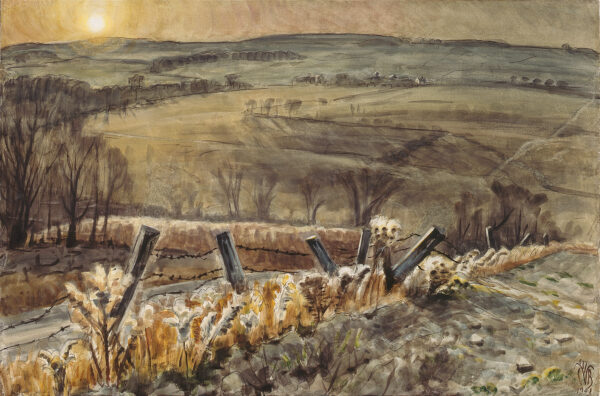
Indian Summer
Burchfield, Charles E.
1941
Artwork Information
-
Title:
Indian Summer
-
Artist:
Burchfield, Charles E.
-
Artist Bio:
American, 1893–1967
-
Date:
1941
-
Medium:
Watercolor, graphite, and pencil on paperboard
-
Dimensions:
23 7/8 x 36 1/8 inches
-
Credit Line:
Wichita Art Museum, John W. and Mildred L. Graves Collection
-
Object Number:
1997.11
-
Display:
Not Currently on Display
About the Artwork
Walt Whitman, one of Charles Burchfield’s favorite poets, wrote his “Song at Sunset” in a voice similar to Burchfield’s visual expression of reverence for nature.
Splendor of ended day floating and filling me,
Hour prophetic, hour resuming the past,
Inflating my throat, you divine average,
You earth and life till the last ray gleams 1 sing.
Open mouth of my soul uttering gladness,
Eyes of my soul seeing perfection,
Natural life of me faithfully praising things,
Corroborating forever the triumph of things.
0 setting sun! though the time has come,
I still warble under you, if none else does, unmitigated adoration.1
Burchfield’s painting of the setting sun during a transitional season represents change: changing light, changing seasons, the inevitability of natural cycles. Burchfield was entering the autumn of his own life when he painted Indian Summer at age forty-eight. His children were growing up, preparing to leave home. American history was evolving, as the United States entered World War 11. This painting does not speak directly to the future drama of war, but instead is nostalgic, reminiscent of the simple agrarian line on the farm of Burchfield’s maternal grandfather.
In the foreground of Burchfield’s painting, a dilapidated barbed wire fence marks a dirt road in the open countryside. In the distance, a small farm nestles into the rolling hills, almost disappearing. The farm is hidden by nature, just as the fence line is nearly obliterated by vegetation. Although the fence and farm buildings provide evidence of human habitation, there are no people in the scene. At one time, these fields were actively plowed or grazed; now they seem abandoned.
Indian Summer exhibits the more realistic style of Burchfield’s middle period, 1918–43. The landscape is rendered in naturalistic hues, laid down in thin layers of watercolor. Warm strokes of yellow, orange and brown delineate plants in the fore ground. With scattered touches of cool greens and pale blues, these colors, both warm and cool, echo the climatic contrasts of early autumn. The high horizon line allows the land’s mass to dominate the image, while the brilliant yellow sun is restricted to a narrow, horizontal band of sky. The warmth of natural light flickers over the landscape in the day’s waning moments. Burchfield captures the transitory nature of the scene; within the hour it will be dark and completely altered.
1. Walt Whitman, Leaves of Grass (1855; New York: Random House, 1993), 607.